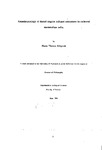Genotoxicology of diesel engine exhaust emissions in cultured mammalian cells
| dc.contributor.author | Kingston, Shaun Thomas | |
| dc.contributor.other | School of Biological and Marine Sciences | en_US |
| dc.date.accessioned | 2013-10-09T12:40:16Z | |
| dc.date.available | 2013-10-09T12:40:16Z | |
| dc.date.issued | 1994 | |
| dc.identifier | NOT AVAILABLE | en_US |
| dc.identifier.uri | http://hdl.handle.net/10026.1/2131 | |
| dc.description.abstract |
Diesel exhaust emissions were collected from a 2 litre direct injection diesel engine using the Total Exhaust Solvent Scrubbing Apparatus (TESSA). Emission samples were collected from a series of two minute engine runs, at a variety of engine speeds and loads which covered the full operating range of the engine. The exhaust extracts collected were then tested for their cytotoxicity and mutagenic potential in cultured Chinese hamster cells. Emission samples were found to be extremely toxic, with most causing 100% cytotoxicity at concentrations of less than 100 /µg/ml. Chromosome aberration studies indicated that less than 50% of the emission samples collected induced increases in the numbers of cells with aberrations, and less than 10% induced aberrations in cell cultures exposed to emission samples with a supplementary metabolic activation system. Samples tested in in vitro sister chromatid exchange assays, induced significant increases in the frequencies of exchanges. Linear trend statistics calculated from chromosome aberration data, were used to reflect the relative clastogenic potential of individual emission samples. Linear regression of these trend values against physical components of the exhaust emissions, showed a significant correlation between sample mutagenicity in aberration assays and the emission of oxides of nitrogen (NOx) in the exhaust. Mapping of NOx emissions to engine conditions has shown that the mutagenicity of diesel emissions from the test engine tend to be highest under condition of low speed/high load and high speed with increasing load. Toxicity assays of subfractions of emission samples isolated by column chromatography has shown that the toxicity of the emission samples is associated with the aromatic and polar components of the samples. The dose responses obtained from mutagenicity assays, in which samples only caused increases in aberrations and chromatid exchanges at the same concentrations at which cytotoxic effects were observed, suggests that the emission may have a limited cytogenetic effects in vivo. Mapping of the clastogenicity of emission samples against engine speed and load, has shown that the most clastogenic samples collected, were emitted under engine conditions that might be expected to occur under urban driving conditions. Results of epidemiological studies of health effects of diesel emissions, and recent associations between particulate emissions and health effects are discussed. | en_US |
| dc.language.iso | en | en_US |
| dc.publisher | University of Plymouth | en_US |
| dc.title | Genotoxicology of diesel engine exhaust emissions in cultured mammalian cells | en_US |
| dc.type | Thesis | |
| plymouth.version | Full version | en_US |
| dc.identifier.doi | http://dx.doi.org/10.24382/3783 | |
| dc.identifier.doi | http://dx.doi.org/10.24382/3783 |
Files in this item
This item appears in the following Collection(s)
-
01 Research Theses Main Collection
Research Theses Main


